27 March 2006
Qatar
To give soldiers a break from their wartime missions and for some units (like mine) to reward soldiers who have been doing an exceptionally good job, the Army has a pass system. For our unit, the people who are awarded a pass get to go down Qatar for four days. Qatar is a peninsula country offshoot of Saudi Arabia located on the Persian Gulf.
In Qatar, the air base there had a variety of events for soldiers (and marines, airmen, and sailors). Everything from water sports and fishing in the Persian Gulf to cultural tours and shopping. When I went, there was some difficulty in getting into the various activities, which was unfortunate. The one event that I did get to participate in off base was golf. I hadn't golfed in almost 3 years. My game showed it. But, it was still fun. Here are some golf pictures:
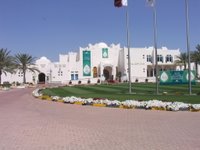


From a cosmetic standpoint, Qatar is very modern looking. There was a lot of construction underway while I was there. A fair amount of money was spent on artistic displays and statues.

Qatar however is far from "modern" from a social standpoint. In many ways, it is a very traditional Muslim country. They have very restrictive laws on speech. Despite the upper 80's temperature, we weren't allowed to wear shorts off base. We weren't allowed to take a picture of any building that had a Qatari flag on it nor were we allowed to take a picture of any Qatari citizens without their permission.
The day prior to the golf, I had a great experience eating a medium rare steak at Chiles (on the air base). Yeah, I know, that sounds lame. But, even though the meat wasn't the quality of a steakhouse back in the states, it was juicy with a pink center.

My mouth is watering just remembering it. Whenever the chow hall serves "steak" (and I use that term very loosely), it is always overcooked (well done and usually dry) and often kept warm by the fact that the steak is held in warm water. The other part of the restaurant experience that was neat is that I forgot (for an hour or so) that I was in the Middle East. It took me back to the feeling of being in any chain sit down restaurant in the states. Again, I know that probably sounds lame, but it was nice to get away (at least psychologically) from the constant reminders of conflict in the Middle East.
Here are a few more pictures:
In Qatar, the air base there had a variety of events for soldiers (and marines, airmen, and sailors). Everything from water sports and fishing in the Persian Gulf to cultural tours and shopping. When I went, there was some difficulty in getting into the various activities, which was unfortunate. The one event that I did get to participate in off base was golf. I hadn't golfed in almost 3 years. My game showed it. But, it was still fun. Here are some golf pictures:



From a cosmetic standpoint, Qatar is very modern looking. There was a lot of construction underway while I was there. A fair amount of money was spent on artistic displays and statues.

Qatar however is far from "modern" from a social standpoint. In many ways, it is a very traditional Muslim country. They have very restrictive laws on speech. Despite the upper 80's temperature, we weren't allowed to wear shorts off base. We weren't allowed to take a picture of any building that had a Qatari flag on it nor were we allowed to take a picture of any Qatari citizens without their permission.
The day prior to the golf, I had a great experience eating a medium rare steak at Chiles (on the air base). Yeah, I know, that sounds lame. But, even though the meat wasn't the quality of a steakhouse back in the states, it was juicy with a pink center.

My mouth is watering just remembering it. Whenever the chow hall serves "steak" (and I use that term very loosely), it is always overcooked (well done and usually dry) and often kept warm by the fact that the steak is held in warm water. The other part of the restaurant experience that was neat is that I forgot (for an hour or so) that I was in the Middle East. It took me back to the feeling of being in any chain sit down restaurant in the states. Again, I know that probably sounds lame, but it was nice to get away (at least psychologically) from the constant reminders of conflict in the Middle East.
Here are a few more pictures:
18 March 2006
Combat Lifesavers
A solid bridge between the self-aid/buddy-aid medical treatment that every soldier is trained on in basic training and the combat medic is the combat lifesaver. The combat lifesaver is a non-medical soldier (e.g., an infantryman, mechanic, tanker, cook) trained to provide emergency care as a secondary mission. When he has completed his combat mission (or then currently has no combat-related task to perform), the combat lifesaver is typically the first responder when an incident happens. When a combat medic is present, the combat lifesaver assists the medic in providing forward care and preparing casualties for evacuation.
The combat lifesaver is taught advanced techniques in casualty assessment, hemorrhage control, and the treatment of tension pneumothorax. Among other training, the combat lifesavers are also taught basic techniques on casualty stabilization and administering IV fluids.
I am a big proponent of combat lifesavers and combat lifesaver training. I personally went through the training and certification a few months back. Well over half of my company is also trained and certified. Time and time again as indicated in after actions reports involving injuries, one of the first things soldiers mention about the incident is that they were so glad that they had a combat lifesaver in the gun truck.
The combat lifesaver is taught advanced techniques in casualty assessment, hemorrhage control, and the treatment of tension pneumothorax. Among other training, the combat lifesavers are also taught basic techniques on casualty stabilization and administering IV fluids.
I am a big proponent of combat lifesavers and combat lifesaver training. I personally went through the training and certification a few months back. Well over half of my company is also trained and certified. Time and time again as indicated in after actions reports involving injuries, one of the first things soldiers mention about the incident is that they were so glad that they had a combat lifesaver in the gun truck.
08 March 2006
The Chatter
I've always wondered about people's behavior. You know, why do people do what they do? Most of the time, people's behavior is understandable. Every once in a while, I observe something that while understandable is still interesting and intriguing to watch. That is the case for what I have come to refer to in my tour here as the Chatter.
Often times, when one experiences something new and incredible, there's a strong desire to tell other people about it. Yes, I know, we're very social creatures. But what I've witnessed (and personally experienced) here is somewhat different than what I've seen on the civilian side. Or, at least is expressed more intensely here--almost an uncontrollable feeling to communicate with fellow soldiers. Let me give a few examples.
One soldier in my company just got back from a mission and it was the first time that he had ever encountered AIF. The soldier is rather shy and not very talkative. But upon returning from this mission, he wouldn't shut up for two days (and I am not exaggerating). He would go on at length about the mission, the small arms fire and the mortar rounds that they took. But it didn't stop there. He would talk about other stuff as well and became much more aggressive in his conversation style. He returned back to his normal self though after a couple of days.
Another example. We had a soldier who got back from a mission at about 2300 one night. During the mission (which lasted about 9-10 days), one of the HMMWV's in front of his was slightly hit by an IED. The driver though lost control of the vehicle and flipped it as they were going about 30-40 mph. No serious injuries thankfully. My soldier witnessed the whole thing as it unfolded. This same soldier also took small arms fire on more than one occasion on this mission. The soldier was still on adrenalin upon his return (even though the events occurred several nights prior). I don't think he even went to bed that night he returned. He told everybody that he saw that night about his mission and what he experienced. This continued for a day or two afterwards. Again, nonstop talking.
What I've noticed that is common among soldiers who exhibit the Chatter is that it occurs most often when soldiers run into the enemy for the first time (or after one of the first few times). The soldier exhibits unusually high levels of exhilaration, excitement, and intensity. In talking to the soldiers, there's also a sense of relief that they made it through the event (or series of events) without serious harm.
Based on my experiences and what I've taken from discussions with other soldiers, my guess is that the Chatter is a combination of a coping mechanism, a soldier bonding mechanism, and an expression of relief following the years of training that the soldier had in preparation of the day he first met the enemy.
I'm sure my observations are not new. But, it's still interesting for me to witness nonetheless. It's also interesting to know that despite all the differences that we have as humans (or at least Americans), there are definitely common behavioral characteristics that almost all of us share. And, the Chatter seems to be one of them.
Often times, when one experiences something new and incredible, there's a strong desire to tell other people about it. Yes, I know, we're very social creatures. But what I've witnessed (and personally experienced) here is somewhat different than what I've seen on the civilian side. Or, at least is expressed more intensely here--almost an uncontrollable feeling to communicate with fellow soldiers. Let me give a few examples.
One soldier in my company just got back from a mission and it was the first time that he had ever encountered AIF. The soldier is rather shy and not very talkative. But upon returning from this mission, he wouldn't shut up for two days (and I am not exaggerating). He would go on at length about the mission, the small arms fire and the mortar rounds that they took. But it didn't stop there. He would talk about other stuff as well and became much more aggressive in his conversation style. He returned back to his normal self though after a couple of days.
Another example. We had a soldier who got back from a mission at about 2300 one night. During the mission (which lasted about 9-10 days), one of the HMMWV's in front of his was slightly hit by an IED. The driver though lost control of the vehicle and flipped it as they were going about 30-40 mph. No serious injuries thankfully. My soldier witnessed the whole thing as it unfolded. This same soldier also took small arms fire on more than one occasion on this mission. The soldier was still on adrenalin upon his return (even though the events occurred several nights prior). I don't think he even went to bed that night he returned. He told everybody that he saw that night about his mission and what he experienced. This continued for a day or two afterwards. Again, nonstop talking.
What I've noticed that is common among soldiers who exhibit the Chatter is that it occurs most often when soldiers run into the enemy for the first time (or after one of the first few times). The soldier exhibits unusually high levels of exhilaration, excitement, and intensity. In talking to the soldiers, there's also a sense of relief that they made it through the event (or series of events) without serious harm.
Based on my experiences and what I've taken from discussions with other soldiers, my guess is that the Chatter is a combination of a coping mechanism, a soldier bonding mechanism, and an expression of relief following the years of training that the soldier had in preparation of the day he first met the enemy.
I'm sure my observations are not new. But, it's still interesting for me to witness nonetheless. It's also interesting to know that despite all the differences that we have as humans (or at least Americans), there are definitely common behavioral characteristics that almost all of us share. And, the Chatter seems to be one of them.
02 March 2006
BIAP and Al Faw Palace
Sorry for the delay in posting everybody. I appreciate all the emails of concern for my well being.
February was a busy month for me (about 3 weeks of various kinds of missions in Iraq). On one of the missions, I had another delay. This time it was in BIAP (f/k/a Sadaam Hussein International Airport). BIAP now not only houses the Baghdad International Airport but also at least three other significant military camps: Camp Victory, Camp Striker, and Camp Liberty. I believe there are a couple of other small camps as well (such as Seitz), but the three that I named are the main ones. The camps are adjacent to one another and for the most part one can travel freely between them.
The overall area is fairly large—I’d guess somewhere between 75-100 square kilometers. It’s situated in the southwestern portion of Baghdad. Three of my crews and I spent a couple hours at the Al Faw Palace, which is what I’ll mostly elaborate on with this post.
The palace itself is built around a man-made lake that is stocked with carp. Here are post card pictures of the palace:
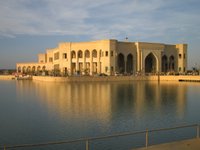
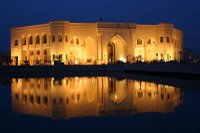

Around the perimeter of the lake is a path that’s roughly 2-2½ miles. There are a number of resort-type buildings there that I’m sure housed the buddies of the man who stopped his hunger strike because he got hungry (i.e., the power hungry sadistic dictator formerly known as President Hussein).
Below are some more pictures of the palace. The outside area and the front door:




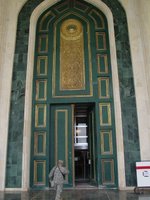
Inside the door of the palace, there's a brief history of the place:

Here's one of the towers that seen better days (prior to 2003).

There are some fairly impressive bathroom facilities in this palace. Here's one of the common areas for a bathroom:

Off of the common area, there are a number of smaller "private" rooms. Here's one:
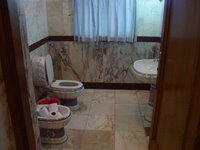
While they probably don’t rival those of certain Chinese-built facilities made for a certain former first lady, they are sure better than the porta-johns that I’ve become well acquainted with over here.
Here are some pictures of the walls, ceilings, and chandeliers:
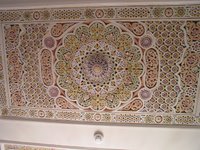
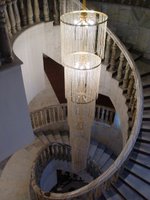



And here’s the chair that I plan to bring back to the office with me.
 Hopefully, there will be room.
Hopefully, there will be room.
February was a busy month for me (about 3 weeks of various kinds of missions in Iraq). On one of the missions, I had another delay. This time it was in BIAP (f/k/a Sadaam Hussein International Airport). BIAP now not only houses the Baghdad International Airport but also at least three other significant military camps: Camp Victory, Camp Striker, and Camp Liberty. I believe there are a couple of other small camps as well (such as Seitz), but the three that I named are the main ones. The camps are adjacent to one another and for the most part one can travel freely between them.
The overall area is fairly large—I’d guess somewhere between 75-100 square kilometers. It’s situated in the southwestern portion of Baghdad. Three of my crews and I spent a couple hours at the Al Faw Palace, which is what I’ll mostly elaborate on with this post.
The palace itself is built around a man-made lake that is stocked with carp. Here are post card pictures of the palace:



Around the perimeter of the lake is a path that’s roughly 2-2½ miles. There are a number of resort-type buildings there that I’m sure housed the buddies of the man who stopped his hunger strike because he got hungry (i.e., the power hungry sadistic dictator formerly known as President Hussein).
Below are some more pictures of the palace. The outside area and the front door:





Inside the door of the palace, there's a brief history of the place:

Here's one of the towers that seen better days (prior to 2003).

There are some fairly impressive bathroom facilities in this palace. Here's one of the common areas for a bathroom:

Off of the common area, there are a number of smaller "private" rooms. Here's one:

While they probably don’t rival those of certain Chinese-built facilities made for a certain former first lady, they are sure better than the porta-johns that I’ve become well acquainted with over here.
Here are some pictures of the walls, ceilings, and chandeliers:





And here’s the chair that I plan to bring back to the office with me.
 Hopefully, there will be room.
Hopefully, there will be room.

